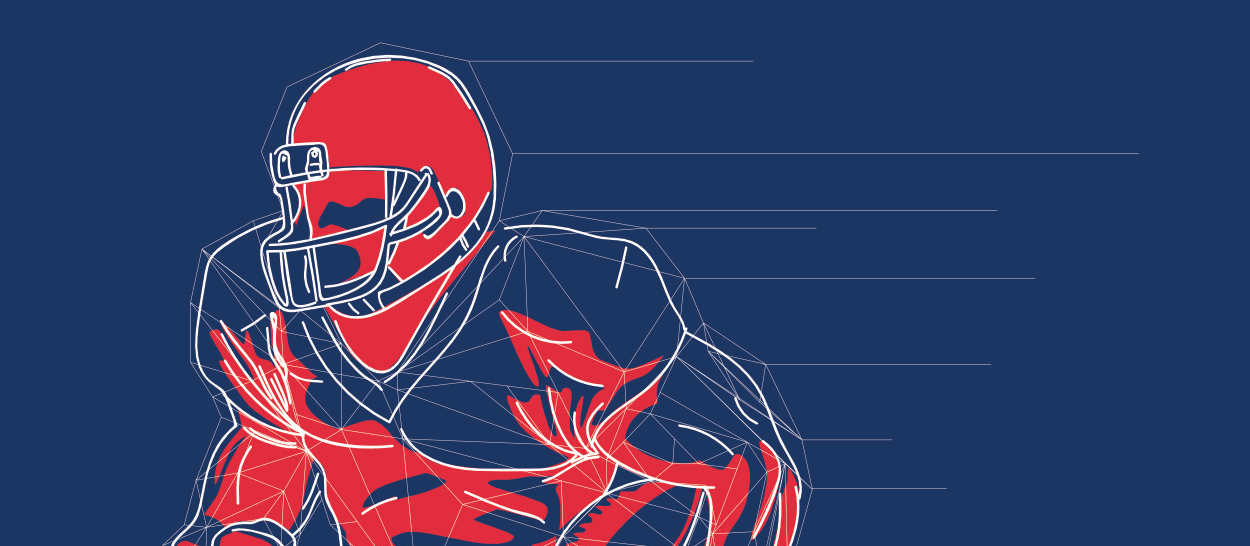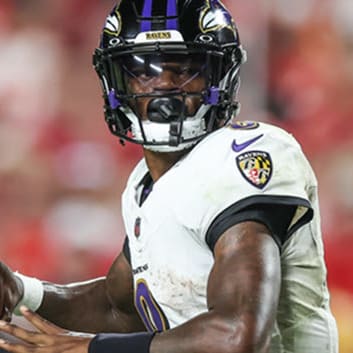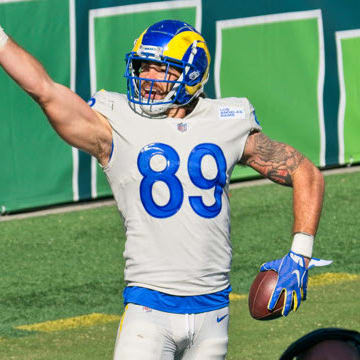This article is part of our Moving the Chains series.
Sometimes, he doesn't.
The shutdown corner (and his friend, the safety over the top) lives to wreck the No. 1 receiver's day. He pushes the receiver around at the line of scrimmage, runs step for step with him down the field, and breaks up or picks off almost any pass thrown his way. If you own guys who are considered their team's No. 1 receiver, it's wise to be wary of the premier corners in the league. Guys like Darrelle Revis, Charles Woodson, Nnamdi Asomugha, and Champ Bailey are, when healthy, perfectly capable of dramatically eating into that huge stat line you were hoping for to win the week.
I have analyzed the job each team has done against the opposing teams' No. 1 receiver. The No. 1 receiver title is a funny thing in the NFL. It does not necessarily describe the receiver who sees the most targets or catches on a team. The No. 1 receiver on a lot of teams does not always lead the team in receiving yards, and he can even go whole games without catching any passes at all. Top receivers are sometimes used solely as deep-ball decoys, and they often get moved to create favorable matchups
Sometimes, he doesn't.
The shutdown corner (and his friend, the safety over the top) lives to wreck the No. 1 receiver's day. He pushes the receiver around at the line of scrimmage, runs step for step with him down the field, and breaks up or picks off almost any pass thrown his way. If you own guys who are considered their team's No. 1 receiver, it's wise to be wary of the premier corners in the league. Guys like Darrelle Revis, Charles Woodson, Nnamdi Asomugha, and Champ Bailey are, when healthy, perfectly capable of dramatically eating into that huge stat line you were hoping for to win the week.
I have analyzed the job each team has done against the opposing teams' No. 1 receiver. The No. 1 receiver title is a funny thing in the NFL. It does not necessarily describe the receiver who sees the most targets or catches on a team. The No. 1 receiver on a lot of teams does not always lead the team in receiving yards, and he can even go whole games without catching any passes at all. Top receivers are sometimes used solely as deep-ball decoys, and they often get moved to create favorable matchups in other areas of the field, such as in the slot.
Keeping this in mind, we have to define the No. 1 receiver. This can partly be achieved through depth chart listings, but find two different depth charts on two different websites and they're sure to disagree heavily. Of course, there is an ideal, Type A No. 1 receiver – Andre Johnson, Roddy White, Calvin Johnson and so on. But there are also great receivers in less favorable situations, such as Larry Fitzgerald, Carolina's Steve Smith, and Lee Evans. They're No. 1s too. So we are going to consider the No. 1 to be, for the most part, a receiver who is clearly on top of the hierarchy of receivers on his team.
Under that definition, I included the following guys: Randy Moss (both in New England and Minnesota, and in Tennessee as we look to the future) Braylon Edwards (for now; arguably, he wasn't the first option last week), Brandon Marshall, Lee Evans, Anquan Boldin, Hines Ward, Chad Ochocinco, Reggie Wayne, Andre Johnson, Mike Sims-Walker, Dwayne Bowe, Malcolm Floyd (and Patrick Crayton in his absence), Brandon Lloyd, Hakeem Nicks, DeSean Jackson (and Jeremy Maclin in his absence), Miles Austin, Santana Moss, Greg Jennings, Johnny Knox, Percy Harvin (now that Moss is gone again), Calvin Johnson, Roddy White, Mike Williams (Tampa Bay), Marques Colston, Steve Smith (Carolina), Mark Clayton (when he was healthy; no one from the Rams in his absence), Larry Fitzgerald, and Michael Crabtree.
Some teams don't have someone who fits the type: Cleveland (sorry, Mohamed Massaquoi), Tennessee (see below), Oakland (no one has emerged as a clear No. 1 there, but Darrius Heyward-Bey has potential), St. Louis (post-Clayton; Danny Amendola is not a No. 1), Seattle (Mike Williams has an argument, but two big weeks don't necessarily put him on top of the totem pole), New England (Wes Welker, Deion Branch, Brandon Tate – are any of those guys clearly No. 1 right now?).
There are also some notable players who aren't represented. Kenny Britt is perhaps the most glaring one. He's hard to exclude – five straight games with touchdowns, including his massive game against Philadelphia. But because Britt wasn't really considered the first option on his team before his massive breakout game, I can't consider him to have been a No. 1 receiver going into it, and I don't think the Eagles played their No. 1 corner, Asante Samuel, on him all game, if at all. If he were to be included, the Eagles would drop precipitously on this list. I also don't consider Nate Washington to be a true No. 1.
Terrell Owens is the other big name that is missing. On most other teams, he'd be a No. 1; but the Bengals consider Ochocinco their No. 1 receiver, so that's who I went with. You can certainly make an argument for finding a way to include TO, who has dropped big games on Cleveland, Tampa Bay, Atlanta, and Miami. Nudge those teams' numbers for the worse in your head if you know that their top corner played on TO much; I wasn't able to see any of those games.
You should know that I have invented the term "cornerpocalypse" (or CPOC) to describe a game in which a receiver does one or more of the following: catches 10 balls, records 110+ yards (because 100 is so passé), or scores multiple touchdowns. In essence, it's a pretty reasonable indicator of how often a No. 1 receiver absolutely torches your top corner. You will probably want the GM of your favorite team to draft a cornerback next year after looking at this list and seeing five CPOCs in the first half of the season. Fact.
Okay, the chart. It is sorted by average yards allowed, lowest to highest. I considered putting cornerback names on it, but some teams tend to roll coverage with safeties and some teams switch it up. So we're really looking, overall, at the most effective team efforts to stop No. 1 receivers. Obviously, some teams will be able to attribute much of that to a specific corner.
| Team | Avg. Catches | Avg. Yards | TD | CPOCs | No No. 1 |
| Broncos | 2 | 26.75 | 2 | 0 | 3 |
| Saints | 3.3 | 39.6 | 1 | 0 | 1 |
| Panthers | 3.2 | 40.7 | 4 | 1 | 1 |
| Buccaneers | 4 | 49 | 6 | 1 | 2 |
| Chargers | 5.5 | 52.3 | 1 | 1 | 5 |
| Bills | 4.3 | 53 | 6 | 1 | 0 |
| Lions | 3.7 | 56.3 | 3 | 1 | 1 |
| Vikings | 4.7 | 57.5 | 1 | 0 | 1 |
| Eagles | 4.3 | 59 | 3 | 0 | 1 |
| Ravens | 3.6 | 59.6 | 5 | 2 | 2 |
| Seahawks | 4 | 64 | 1 | 1 | 1 |
| Titans | 5.6 | 64.3 | 1 | 2 | 1 |
| Dolphins | 3.9 | 64.4 | 3 | 2 | 0 |
| Packers | 4.4 | 64.6 | 3 | 3 | 0 |
| Colts | 4 | 65.1 | 3 | 1 | 0 |
| Chiefs | 4.7 | 65.3 | 2 | 1 | 1 |
| Patriots | 5.6 | 65.9 | 3 | 1 | 0 |
| Steelers | 7.2 | 73.2 | 1 | 1 | 2 |
| Raiders | 3.4 | 73.2 | 5 | 2 | 3 |
| Bears | 5.8 | 75.6 | 2 | 2 | 2 |
| Browns | 5.7 | 77.6 | 7 | 2 | 0 |
| 49ers | 4.5 | 79.2 | 2 | 1 | 2 |
| Giants | 4.3 | 79.3 | 3 | 1 | 1 |
| Jets | 4.9 | 79.4 | 3 | 1 | 0 |
| Texans | 6.8 | 80.8 | 6 | 3 | 1 |
| Bengals | 5.8 | 81.5 | 3 | 1 | 1 |
| Rams | 5.5 | 84.2 | 3 | 2 | 2 |
| Redskins | 6.6 | 86 | 6 | 3 | 0 |
| Cardinals | 6 | 88.8 | 2 | 1 | 2 |
| Cowboys | 6 | 90 | 3 | 2 | 1 |
| Falcons | 6.7 | 95.5 | 3 | 2 | 1 |
| Jaguars | 6.1 | 105.6 | 5 | 5 | 1 |
The first think you'll notice is that it sure looks like Champ Bailey is the best cornerback in football this year, and also that the Jags' corners are terrible. To be fair, the Broncos have had an easy schedule as far as receiver quality goes. Anquan Boldin (1 catch for 8 yards) was the best receiver that Denver faced, and they have played three teams without a clear No. 1. (That's what "No No. 1" means, by the way.) But that's not as ridiculous as San Diego, where Quentin Jammer has been lucky enough to play Seattle, Oakland, New England post-Moss, Tennessee pre-Moss, and St. Louis post-Clayton. Also, Darrelle Revis was not healthier earlier in the year, and now that he is, the Jets are sure to rise on the list.
The Saints have done spectacular work on No. 1 receivers. Jabari Greer has been great. New Orleans can lay claim to limiting Roddy White about as well as anyone has this year (five catches for 69 yards and a score, his lowest yardage of the year), and they absolutely closed the door on Percy Harvin, Michael Crabtree, Hines Ward and Carolina's Smith, allowing those four to catch a combined seven passes for 70 yards.
The Panthers aren't as good as they look. When they played the Bears, Johnny Knox put up just one catch for 14 yards, thanks to being thrown to by Todd Collins and Caleb Hanie. Carolina has faced very few of the NFL's elite receivers.
Here are a couple notes before this column gets much longer: Pittsburgh is notable for giving up the highest average number of completions - Roddy White's 13 catches in Week 1 skew that - but they fall in the middle of the pack in yardage. The Ravens have totally shut down Braylon Edwards (with some help from the playcalling), Chad Ochocinco, and Hines Ward, but they have also given up huge games to Brandon Lloyd and Lee Evans, not to mention Deion Branch, whose nine catches for 98 don't count against Baltimore here.
Get up, stretch a bit, and feel free to discuss.










